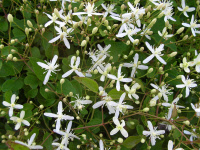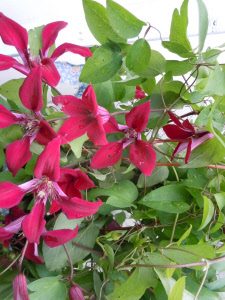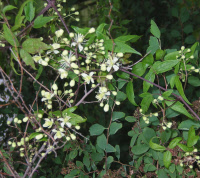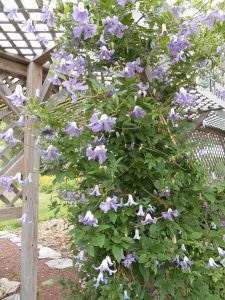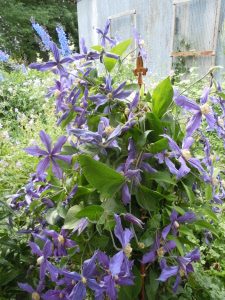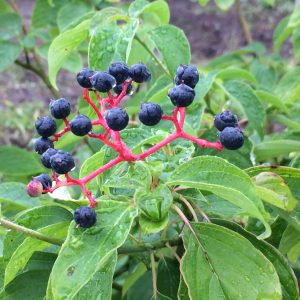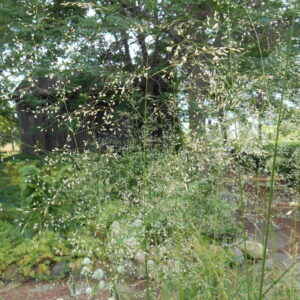Black Walnut Tolerant
Showing 33–40 of 110 results
-
Clematis ternifolia Sweet Autumn clematis Z 4-8
Fragrant, small white blossoms smother this vigorous vine
Fragrant, small white blossoms smother this vigorous vine in September and October.
Can not ship to: Alabama, Delaware, Florida, Georgia, Maryland, Nebraska, New York, North Carolina, South Carolina, Tennessee and Virginia.
Size: 15-20’ x 6-10’
Care: Sun moist well-drained soil mulched. Flowers on current year’s wood. Cut back in early spring to 6-8” above the soil.
Native: JapanThe genus Clematis was named by Dioscordes, physician in Nero’s army, from “klema” meaning climbing plant. In 1877 seeds of this vine sent from Russia to the Arnold Arboretum in Boston, then distributed to nurseries throughout America.
-
Clematis texensis ‘Gravetye Beauty’ Z 5-9
Small crimson-red bells dangle from July to September
Small crimson-red bells dangle from July to September
Size: 8’ x 3’
Care: Full sun in humusy, fertile, moist well-drained soil. Mulch around the base. Flowers on current year’s stems so cut back to 6-8” in late winter or early spring.The genus Clematis was named by Dioscordes, physician in Nero’s army, from klema meaning “climbing plant.” The species 1st collected by the “Father of Texas Botany” Ferdinand Lindheimer in 1830’s. Max Leichtlin of the Baden Botanic Garden sent C. texensis to Kew Botanic Garden in London in 1880. French nurseryman Francisque Morel sent this selection to William Robinson. Robinson named it for his English nursery at Gravetye Manor in 1914
-
Clematis virginiana Virgin’s bower, Devil’s darning needles Z 4-8
July-September star-like white blossoms
July-September star-like white blossoms cover this vine – good for clambering up small trees.
Size: 12-20’ x 4’
Care: Sun to shade moist well-drained soil. Flowers on new stems so cut back in late winter or early spring to 6-8” above the ground.
Native: Nova Scotia to Georgia and as far west as Kansas, Wisconsin nativeThe genus Clematis was named by Dioscordes, physician in Nero’s army, from “klema” meaning climbing plant. One of 1st No. American plants sent to Europe – grew in Tradescant the Elder’s South Lambeth nursery in 1634. Grown by Jefferson at Monticello in 1807. Described by Breck in his 1851 book The Flower Garden: “The flowers are white borne upon cymes, and make a handsome appearance.” Cherokee mixed this plant with milkweed to remedy backaches. A root extract cured stomach aches, nervous conditions and kidney ailments. For the Iroquois powdered root fixed venereal disease sores and an extract of the stem brought on strange dreams. Pressed specimen in Emily Dickinson’s herbarium.
-
Clematis viticella ‘Betty Corning’ Z 3-9
Pendulous lavender trumpets
Pendulous lavender trumpets with bodacious flares bloom profusely, blooming machine all summer into fall.
Size: 8-10’ x 8’
Care: sun to shade in moist well-drained soil. Prune back to 1’ above ground in early spring.
Awards: Elisabeth Carey Miller Botanic Garden Great Plant Pick; Cary Award Distinctive Plants for New England; and England’s Royal Horticultural Society Award of Garden Merit.Selection of a cross between Clematis crispa and C. viticella, made in 1932 by Betty Corning.
-
Clematis x durandii Z 5-9
Big blue flowers from June to September
OUT OF STOCK
Big, deep indigo saucers – all summer into fall. The best short Clematis.
Size: 3-6' x 3'
Care: Full sun in moist well-drained to well-drained soil Prune back to a few inches above the ground in April. Needs staking or let it sprawl.
Awards: Elisabeth Carey Miller Botanical Garden Great Plant Pick.Cross of C. integrifolia and C. x Jackmanii, of garden origin. Hybrid from Durand in Freres France in 1874. William Robinson, father of mixed perennial borders, called this “effective and free.” (1933)
-
Cornus alternifolia Pagoda dogwood Z 4-7
Small tree with horizontal branches in flat tiers & a flat top, like the roof of a pagoda, bearing fragrant white flowers in early summer & blue berries on red stems against maroon leaves in fall.
Small tree with horizontal branches in flat tiers & a flat top, like the roof of a pagoda, bearing fragrant white flowers in early summer & blue berries on red stems against maroon leaves in fall.
Size: 15-30’ x 15-30’
Care: part shade in moist to moist well-drained soil – great understory tree.
Native: Canada to GA, west to MN – WI native
Wildlife Value: Spring azure butterfly caterpillar. 34+ birds (incl. Northern flicker, Woodpeckers & Bluebirds,) eat the fruits.
Awards: Great Plants for Great PlainsAlternifolia means leaves alternating on stem. Cherokee chewed bark for headaches, sore throat, worms, measles & diarrhea. Poltice topically applied on ulcers & a decoction for colds & cough. Collected before 1753. Grown at America’s 1st botanic garden, Elgin Botanic Garden 1811.
-
Corylus americana American Hazelnut, Filbert Z 4-9
In spring, showy male flowers on 2-3" long catkins. Female flowers appear in small, reddish catkins grow into half inch long, egg-shaped edible nuts. Fall color ranges from orange, rose, purplish red, yellow and green.
In spring, showy male flowers on 2-3″ long catkins. Female flowers appear in small, reddish catkins grow into half inch long, egg-shaped edible nuts. Fall color ranges from orange, rose, purplish red, yellow and green.
Size: 10-16’ x 8-1’
Care: sun in any soil
Native: E. North America including Wisconsin
Wildlife Value: Exceptionally high value to wildlife. Pheasant, Quail, Turkey, Grouse, Turkey & Blue Jay and small animals eat the nuts. Pollen source for bees, host to many caterpillars both butterflies and moths. Branches make good nesting sites for songbirds. Black walnut tolerant.Described by Thomas Walter in 1788. Food for several Native American tribes. Medicinal for Cherokee, Iroquois, Menominee, Meskwaki and Ojibwa, to remedy hives, fever, headaches, pain of baby’s teething, hay fever and induce vomiting.
**LISTED AS OUT OF STOCK BECAUSE WE DO NOT SHIP THIS ITEM. IT IS AVAILABLE FOR PURCHASE AT OUR RETAIL LOCATION.
-
Deschampsia caespitosa Hair grass Z 4-9
Airy pink panicles, like delicate billowing clouds of seed heads, top clumps of arching slender leaves in mid- summer persisting through winter.
Airy pink panicles like delicate billowing clouds of seed heads, top clumps of arching slender leaves in mid-summer persisting through winter.
Size: 2-4' x 18"
Care: moist soil in sun to shade
Native: Europe, Asia & No. America, Wisconsin nativeDeschampsia named for French botanist Deslongchamps (1774-1849.) Caespitosa means that it grows in clumps. Named and described in 1753.

